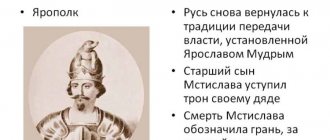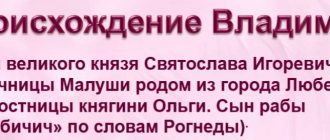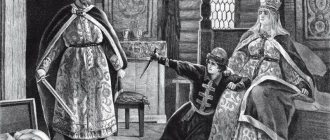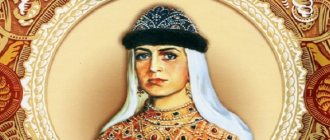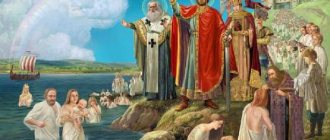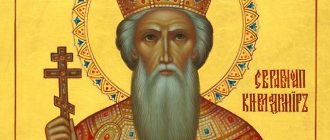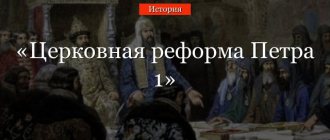In Ancient Rus', Christianity appeared long before the adoption of the official status of religion. Of course, it was rather poorly spread, but it could not compete with paganism in the same way.
Trade relations with Greece made it easier for Ancient Rus' to become acquainted with the Christian faith. For example, Varangian merchants, before the Slavs, went to Constantinople and converted there to Christianity. Then they came to Rus' and brought new teachings, passing them on to the Slavs.
The baptism of Rus' came immediately after the baptism of Prince Vladimir and his squad
The religious activities of Prince Vladimir were aimed at strengthening princely power
The religious activities of Prince Vladimir were aimed at strengthening princely power. The opinions of historians on this matter are similar.
N.M. Karamzin spoke about Vladimir:
Nikolay Karamzin
Russian writer and historian
“... His (Vladimir’s) main right to eternal glory and gratitude of posterity is that he put Russians on the path of the true faith; but the name of the great belongs to him and for his state affairs...”
Let's take a closer look at the religious reforms of Prince Vladimir.
For the early feudal state, paganism was a rather unprogressive form of state religion, which is why Grand Duke Vladimir took measures to establish correspondence between religion and the political system.
Prince Vladimir carried out two religious reforms:
- this is the reformation of paganism;
- conversion to Christianity of all people.
988
this year Vladimir and his squad converted to Christianity
The first boiled down to the fact that Vladimir must select several main ones from among the pagan gods. Among them, the god Perun stood out, he was the patron saint of the princely squad, as well as other deities of the southern East Slavic regions.
This reform was insufficient, because the feudal state already required the approval of a monotheistic religion, which best illuminated the power of the Grand Duke. There were only 3 such religions in Kyiv - Christianity, Islam and Judaism.
Equal to the Apostles Prince Vladimir and Equal to the Apostles Princess Olga. It was they who made the decision which Christianity was better to accept - Western or Eastern
Princess Olga, as well as Prince Vladimir, had to accept such an important question as to which Christianity to accept - Western or Eastern. Then he began to think.
It was much more profitable for Kiev to deal with Constantinople, because in its hands there was a waterway “from the Varangians to the Greeks,” and long-established economic and political relations had long existed with Byzantium, although they were not always peaceful.
For many years, Kyiv communicated with Constantinople, and therefore, in connection with the West, they were much weaker, so preference was given to Eastern Christianity.
See also the article Why Vladimir did not convert to Islam
Administrative reforms and rule of succession to the throne
Sons of Vladimir appointed to reign in different cities
Scheme - the second civil strife in Rus' The second civil strife
Chronicles report that after the capture of Kyiv, Vladimir got rid of the most aggressive Varangians, having first deceived them and not giving the promised tribute from the Kievites. Before sending the Varangians to Constantinople, the prince selected some of them and distributed them to the city administration. As his many sons grew up, Vladimir appointed them instead of the Varangian mayors to govern the most important cities of the state, thus strengthening his own power, but predetermining the civil strife that would soon follow. At the end of his life, Vladimir decided to change the rule of succession to the throne by seniority and entrusted the leadership of the grand ducal squad to his beloved son, Boris. Soon, his son Yaroslav the Wise, appointed by him to rule in Novgorod, refused to pay his father an annual tribute of 2000 hryvnia, and the eldest son Svyatopolk the Accursed was accused by his father of attempting a conspiracy and put in prison.
Immediately after the death of Vladimir, a bloody civil strife broke out between his sons, in which many of them were killed.
Foreign policy of Vladimir I
Domestic policy of Vladimir I
Section "Vladimir I"
In 988, Prince Vladimir, together with his retinue, was baptized
In 988, the prince and his squad converted to Christianity. It was the baptism of the prince that was followed by the adoption of Christianity throughout Rus'.
The new religion met not only the interests of the nobility and warriors, but it also satisfied the needs of the social system, which established itself as dominant in ancient Rus'.
But, unfortunately, although people accepted Christianity, the Christianization of Rus' did not make it Orthodox. Many regions of the country, that is, part of the population, took baptism for quite a long time, over several centuries.
Fight against the Pechenegs
The Pechenegs, driven back from the walls of Kiev by Svyatoslav, did not stop their raids; the struggle of Russia against the Pechenegs continued. In 990, 993 and 996. their hordes again violate the borders of the Old Russian state. In 996, the Pechenegs inflicted a crushing defeat on the Russian squad. A battle between Vladimir and the Pechenegs took place near Vasilev , in which the nomads almost took the prince’s life. This victory is considered his only known defeat in the fight against nomadic peoples. The following year, the emboldened Pechenegs attacked Kyiv, and in 1001 and 1013. having united with the Poles, they penetrate further into the interior of the country.
To combat Pecheneg raids, Vladimir begins full-scale construction of border fortresses. In the south and southeast of the country, along the left and right banks of the Dnieper, earthen trenches, ramparts and outposts (a well-fortified observation and defensive point) appeared. The length of the earthen ramparts around Kyiv reached 800 km (Serpentine Shafts). The soldiers stationed at the outpost had to be constantly on guard; the Pechenegs roamed no more than 1 day's journey from the border and were always ready for an attack. The struggle of the Old Russian state with the Pechenegs did not subside.
Vladimir completely , but he still managed to stop them and prevent the significant damage that the nomadic raids inflicted on peaceful peasants. Briefly, the struggle of Russia with the Pechenegs is presented as a series of endless battles that lasted for several decades.
Russian horseman fights with the Pecheneg
Orthodoxy - ranks first among religions in the country
Now let's talk about how the baptism of the prince took place, and then the baptism of Rus'. As we see, for almost 900 years Orthodoxy was the state religion in Russia.
Now the Orthodox religion ranks 1st in the country.
How did Rus' move away from paganism and accept the Orthodox faith?
In fact, Prince Vladimir watched his people for a very long time and noticed how much different crude and violent paganism is from high Christian teaching, because quite a lot of Christians lived in Kiev at that time, and in Prince Vladimir’s squad itself there were many Orthodox Christians.
After receiving baptism, Prince Vladimir ordered the destruction of all idols
After Prince Vladimir chose Christianity, he ordered the destruction of all idols. Many, seeing this, cried bitterly; they did not want to accept another faith. Then the prince, angry, said that those who would not go with him to accept the new faith were going against him.
After the baptism of Prince Vladimir (he can be seen in the photo), the Christianization of ancient Rus' began
The most important thing that Christianity gave to Rus' is church writing
But what was the reason for Russia’s adoption of Christianity? Why did the prince, among many religions, choose this? This is explained by the fact that paganism is simply a set of beliefs, cults, but not teachings. And the Christian faith is a teaching, a teaching about Christ.
People also had a desire to get out from under the swamps and steppes, but they wanted to get to know the world as soon as possible. At that time, Prince Vladimir was still trying to merge the heterogeneous gods of all tribes, but this failed.
The decisive step to accept Orthodoxy was the fact that, in my experience, Byzantium had long been famous for its traditional political and economic ties. And in the Byzantine system, spiritual power occupied a subordinate position to the emperor himself.
The most important thing that Christianity gave to Rus' was church writing, which was given by Bulgaria
This corresponded to Vladimir’s political views and aspirations. This further strengthened relations between Kyiv and Byzantium.
With the help of Bulgarian writing, Christianity immediately appeared in Rus' in the form of a highly organized religion, with a fairly high culture. The most important thing that Christianity gave to Rus' was church writing, which was given by Bulgaria.
It was this writing that allowed Rus' not to start literature, but allowed it to continue it, as well as create works that could be proud of.
By leaving a comment, you accept the user agreement
Coinage
Rice. 2. Western European silver denarii of the late 10th – early 11th centuries, Photo by A.Ya. Lavrentieva
The beginning of the minting of Rus''s own coins (zlatniks and silver coins) did not so much meet the requirements of the economy (the monetary circulation of Rus' was ensured by imported Byzantine, Arab and Western European coins; Rus' did not have its own sources of coin metal), but rather it was a political declaration of the sovereignty and significance of the Russian state. Most of the coins of Vladimir depict the prince sitting on a throne and the inscription: “Vladimir na stole” (Vladimir on the throne). Judging by the incomplete form of the words (not Volodimir, but Vladimir; not gold, but zlato), the coinmakers were Bulgarians.
Only on the coins were the lifetime symbolic images of Prince Vladimir, a man with a small beard and long mustache, preserved. The princely sign of Vladimir - the trident - is also known from coins. Judging by the small number of copies that have come down to us, the production of gold coins was extremely short in time (perhaps one or two years) and small in volume. However, all currently known examples of zlatniks were found in treasures along with other coins of that time and bear traces of being in circulation - therefore, these coins were not ritual, reward or gift.
Zlatnik and Srebrenik of Vladimir I Svyatoslavich
Variant of the coin with the image of a trident
